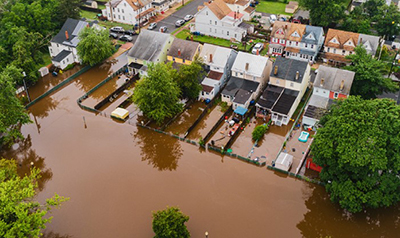
Who Owns Climate Risk? MBA White Paper Examines Challenges, Risks for U.S. Real Estate

(from cover of MBA White Paper, Who Owns Climate Risk in the U.S. Real Estate Market?)
The Mortgage Bankers Association issued a white paper examining how climate change is dramatically reshaping lenders’ and policymakers’ approaches to the U.S. real estate market.
The paper, Who Owns Climate Risk in the U.S. Real Estate Market?, was presented this week at the American Real Estate and Urban Economics Association’s International Conference in Dublin by MBA Chief Economist Mike Fratantoni, who co-authored the paper with MBA Vice President of Commercial Real Estate Research and Economics Jamie Woodwell and Edward Seiler, Executive Director of the MBA Research Institute for Housing America and MBA Associate Vice President, Housing Economics.
“Physical, economic and social changes associated with a changing climate will directly affect the $50 trillion single-family residential real estate and $25 trillion commercial real estate markets in the United States,” the paper says. “Because real estate owners and other real estate market participants keenly focus on the identification, assessment, mitigation, underwriting, insurance and pricing of risk, they create a unique case study for understanding the ways in which climate-related risks are likely to impact individual actors and the market ecosystem as a whole.”
The paper notes the real estate market also provides key insights into where regulators will need to pay increased attention — to identify changes in the composition or concentration of risk in existing risk structures and in relationships that are already undertaking risk management associated with climate change.
“Modeling the ‘ownership’ of risks illuminates under which circumstances homeowners, insurance providers, lenders, investors and others do and do not take on physical, transition and other risks, and the level of risk ‘owned’ by each,” the paper says. “We find that owners bear the burden of paying for the risks, in some circumstances through explicit or implicit insurance, but that the ways in which responsibility for climate risk is distributed among the various market players is heavily dependent on whether the property owner does or does not have a mortgage in place and whether that mortgage is held in a lender’s portfolio or sold into the secondary market. The results have broad implications for where risk management and regulation can have the most significant impacts.”
The paper discusses the changing climate and its impacts on the U.S. financial system; building a climate risk framework for the housing and mortgage markets; applying exsiting risk management regimes to climate change-related risks; and policy questions and implications.
Key findings include:
–Climate-related housing risks are distributed among a wide range of market actors, with “ownership” of the risk heavily dependent on the degree to which a property is insured, mortgaged and, if mortgaged, by the form of mortgage ownership.
–Even with the distribution of risks, property owners continue to bear the first-loss risk for both physical and transition risks related to climate change.
–The insurance market is a key piece of the system for physical risks. Other players are dependent on its resilience and stability and the mortgage market promotes the use of the P&C and other markets for physical risks. The insurance market is generally built to avoid transition risks.
–The mortgage market acts a de facto form of insurance for climate-related transition risks, taking on the risk from an attachment point of the owner’s equity in the property through to a detachment point of the property’s value. The amount of risk/coverage homeowner experience depends on the loan loan-to-value ratio.
–As the market prices climate-related risks, property owners will bear the costs for the explicit or implicit insurance that others in the market provide.
–Portfolio lenders’ greatest exposures to climate-related risk in the housing market are through transition risk on the loans they hold in portfolio and through counterparty and operational risks.
–A portfolio lender’s risk is diversified to the degree it has a diversified portfolio.
–Lenders and servicers bear no direct physical or transition risk for loans that are sold/securitized, although servicers bear some operational risk for such loans.
–Investors in mortgage assets take on climate-related risks from the initial lender and distribute them into heterogenous pools and more risk-absorbing pocket.
